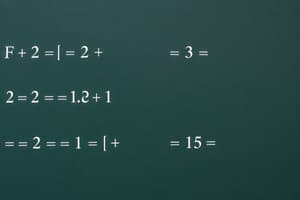Podcast
Questions and Answers
¿Cuál es la forma general de una ecuación lineal en una variable?
¿Cuál es la forma general de una ecuación lineal en una variable?
- ax + b = 0 (correct)
- a + bx = 0
- ax^2 + b = 0
- a + b = 0
¿Cuál de las siguientes afirmaciones es correcta sobre las soluciones de ecuaciones lineales?
¿Cuál de las siguientes afirmaciones es correcta sobre las soluciones de ecuaciones lineales?
- Las ecuaciones lineales siempre tienen dos soluciones.
- Una ecuación lineal puede tener una solución única, infinitas soluciones o ninguna solución. (correct)
- Una ecuación puede tener siempre al menos una solución.
- Una ecuación puede tener soluciones irracionales pero no enteras.
Si tienes la ecuación 3x + 2 = 2x + 5, ¿cuál es el primer paso para resolverla?
Si tienes la ecuación 3x + 2 = 2x + 5, ¿cuál es el primer paso para resolverla?
- Restar 2 de ambos lados.
- Restar 2x de ambos lados. (correct)
- Multiplicar ambos lados por 3.
- Sumar 3 a ambos lados.
¿Qué indica la ecuación 5x + 1 = 5x + 3?
¿Qué indica la ecuación 5x + 1 = 5x + 3?
¿Cuál de los siguientes pasos se debe realizar primero para resolver la ecuación 4(x + 2) = 28?
¿Cuál de los siguientes pasos se debe realizar primero para resolver la ecuación 4(x + 2) = 28?
Al resolver 2x - 4 = 10, ¿cuál es el resultado final para x?
Al resolver 2x - 4 = 10, ¿cuál es el resultado final para x?
Si una ecuación tiene un coeficiente de variable igual a cero, ¿qué tipo de solución puede tener?
Si una ecuación tiene un coeficiente de variable igual a cero, ¿qué tipo de solución puede tener?
¿Cuál operación ayuda a simplificar la ecuación 6/2x = 3?
¿Cuál operación ayuda a simplificar la ecuación 6/2x = 3?
Al aplicar la propiedad distributiva en la ecuación 4(2x + 3) = 28, ¿cuál es la expresión resultante?
Al aplicar la propiedad distributiva en la ecuación 4(2x + 3) = 28, ¿cuál es la expresión resultante?
¿Qué operación realizas para resolver la ecuación 5x - 3 = 2x + 6?
¿Qué operación realizas para resolver la ecuación 5x - 3 = 2x + 6?
Flashcards
Ecuación de primer grado
Ecuación de primer grado
Una ecuación algebraica donde el exponente más alto de la variable es 1. También se conoce como ecuación lineal.
Forma general de una ecuación lineal
Forma general de una ecuación lineal
La forma general de una ecuación lineal con una variable (x) es ax + b = 0, donde 'a' y 'b' son constantes, y 'a' ≠ 0.
Resolver una ecuación lineal
Resolver una ecuación lineal
El objetivo es aislar la variable (x) en un lado de la ecuación.
Combinar términos semejantes
Combinar términos semejantes
Signup and view all the flashcards
Sumar o restar en una ecuación lineal
Sumar o restar en una ecuación lineal
Signup and view all the flashcards
Multiplicar o dividir en una ecuación lineal
Multiplicar o dividir en una ecuación lineal
Signup and view all the flashcards
Propiedad distributiva
Propiedad distributiva
Signup and view all the flashcards
Solución única
Solución única
Signup and view all the flashcards
Sin solución
Sin solución
Signup and view all the flashcards
Infinitas soluciones
Infinitas soluciones
Signup and view all the flashcards
Study Notes
Equations of the First Degree
- Equations of the first degree are algebraic equations where the highest exponent of the variable is 1. They are also known as linear equations.
- The general form of a linear equation in one variable (x) is ax + b = 0, where 'a' and 'b' are constants, and 'a' ≠ 0.
- To solve a linear equation, the goal is to isolate the variable (x) on one side of the equation.
Solving Linear Equations
- Combining Like Terms: Simplify both sides of the equation by combining any terms that have the same variable and exponent.
- Adding or Subtracting: Add or subtract the same value from both sides of the equation to isolate the variable term.
- Multiplication or Division: If the variable is multiplied or divided by a constant, perform the opposite operation on both sides of the equation to isolate the variable.
- Distributive Property: If parentheses are present, apply the distributive property to eliminate them before proceeding with the other steps.
- Example: Solve 2x + 5 = 11; Subtract 5 from both sides: 2x = 6; Divide both sides by 2: x = 3
Types of Solutions
- Unique Solution: A linear equation has one unique solution if the coefficient of the variable (x) is not zero.
- No Solution: A linear equation has no solution if the variable terms cancel out and the constant terms are unequal. For example, 2x + 3 = 2x + 7.
- Infinite Solutions: A linear equation has infinite solutions if both sides of the equation are identical when simplified. For example, 2(x + 1) = 2x + 3 (simplifies to 2x + 2 = 2x + 2).
- Important Note: Equations can involve fraction coefficients. Multiplying both sides by the least common denominator (LCD) of the fractions can make solving easier, removing the fractions.
Applications of Linear Equations
- Linear equations are used in numerous applications, including:
- Geometry: Calculating areas, perimeters, and angle measures.
- Business: Modeling costs, revenues, and profits.
- Physics: Describing motion, force, and work.
- Everyday Problems: Solving practical situations involving unknown values, such as calculating ingredient amounts for a recipe or time needed to complete a task.
Key Concepts
- Variable: A symbol (usually a letter) that represents an unknown numerical value.
- Constant: A fixed numerical value.
- Equation: A mathematical statement that shows the equality of two expressions.
- Solution: The value of the variable that makes the equation true.
- Equivalent Equations: Equations that have the same solution.
Studying That Suits You
Use AI to generate personalized quizzes and flashcards to suit your learning preferences.





